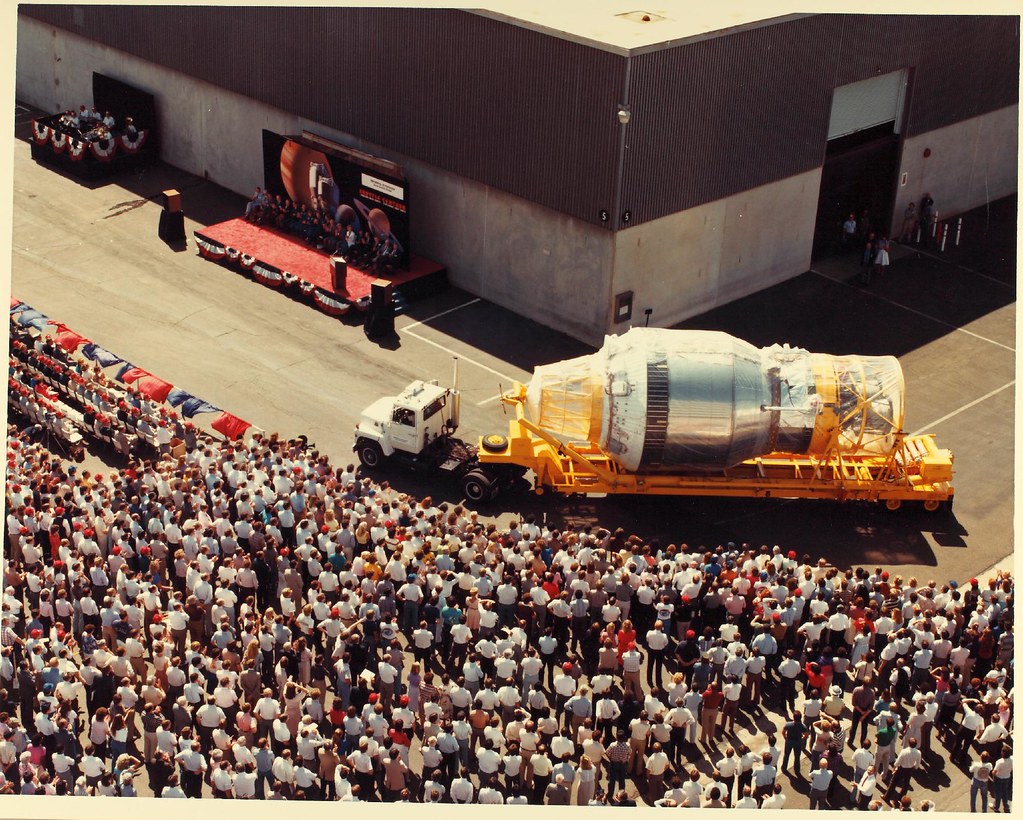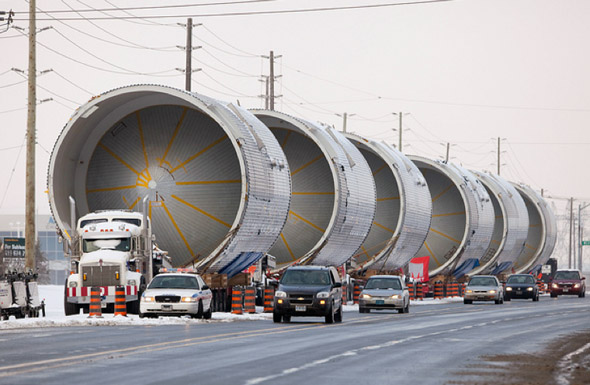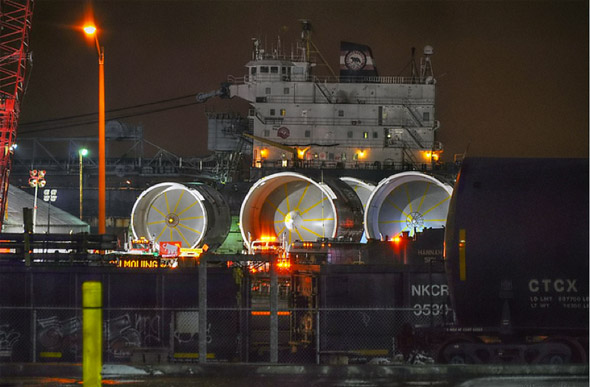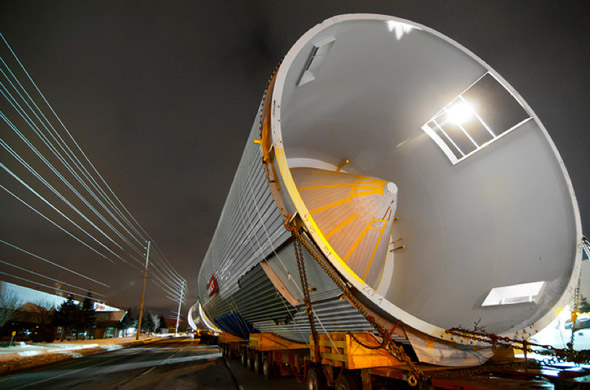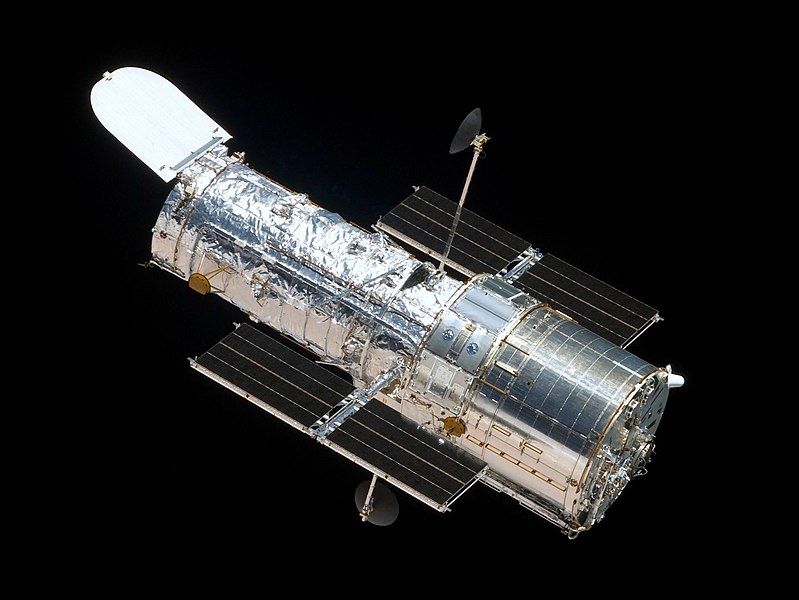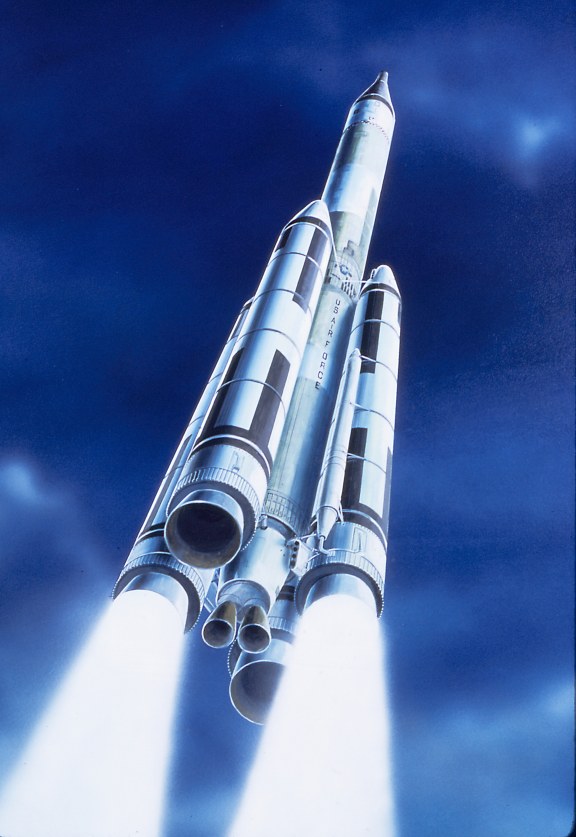Well, it's that time once again. Last week, we covered launch operations up to the retirement of Spacelab and Salyut 7. This week, though, we're jumping back a tiny bit to one of the most important single payloads of the 80s: the Hubble Space Telescope. The eagle-eyed among you might note that this post is going up a bit early, but that's both good and bad news. I've been having a serious computer issue that's been preventing me from being able to make progress on pulling images of my models for the assembly posts about Mir and Freedom. That's supposed to be next week's post, but if I can't get it ready, we may have to slip. I've been proud of not having to until now, and we're doing our best to avoid it, but we may be forced to. Anyway, I wanted to note that possibility.
1121 comments, 137649 views
Eyes Turned Skyward, Part II: Post 21
By the early 1970s, after a round of preliminary studies examining the space telescope concept, Goddard and Marshall had emerged as the principal competitors to lead the Large Space Telescope program. While the interest of Goddard, which was managing the Orbiting Astronomical Observatory program and had a substantial staff astronomer population, in the next generation of space telescopes was obvious, Marshall’s interest was perhaps more surprising in light of its traditional role as developer of rockets and rocket engines. The essential problem that led Marshall leadership to become interested in the telescope was that of Marshall’s future. Since the glory days of the mid-1960s, Marshall’s budget and staff had collapsed, falling dramatically over the past several years, while rumors circulated that the center might even be closed if more aggressive budget cutters within the Administration or Congress had their way. Despite the beginning of the Spacelab and Saturn IC programs, which promised to provide Marshall with jobs for many years to come, the center’s management, together with Headquarters leadership, therefore felt that the center was still vulnerable, and needed additional projects to justify its continued existence. By contrast, Goddard was busy with the Orbiting Astronomical and Orbiting Geophysical Observatories, together with a bevy of other more minor programs, and was perhaps even oversubscribed, leading its management to be complacent and inactive in “selling” Goddard as the program’s lead center. Nevertheless, there were strong counterarguments against Marshall becoming the lead center. Unlike Goddard, Marshall had little experience with space observatories, surely a disadvantage considering the limited budgets on the horizon for the remainder of the 1970s, and had a well-known reputation for gold-plating and going over budget. Furthermore, while at the moment Marshall was suffering badly from falling budgets and limited staffing, by the late 1970s, when most of the actual work for the telescope would be taking place, the situations at Goddard and Marshall would be reversed; the former, its main programs of the moment having ended, would be casting about for work while the latter would be increasingly occupied with Spacelab and Saturn IC operations and construction. Therefore, in late 1972 Goddard Space Flight Center was selected to manage the overall Large Space Telescope program, mainly in order to centralize the program in anticipation of the beginning of Phase B planning that year and an overall program start in three to four years.[1]
The selection of Goddard as lead center proved to be program-defining, as the center had developed a conception of the Large Space Telescope as an evolutionary development from prior space telescope programs, especially the OAOs.[2] Nowhere was this demonstrated more clearly than in the draft telescope program the center developed shortly after its selection as lead center, where the Large Space Telescope would be gradually developed via a series of intermediate steps taking full advantage of technologies and designs developed for the OAOs. Although a quick casualty of NASA’s budget pressures, the draft program was nevertheless indicative of Goddard’s attitude towards the project, an attitude which would go on to shape its future management in deep ways. In the short-term, an evolutionary program offered obvious ways of cutting costs, increasingly the top priority in the minds of Headquarters management concerned with fitting NASA into the tight box dictated by Congress and the President. Rather than develop entirely new systems and technologies, or even in some cases new parts, those developed for prior programs could be reused and repurposed, taking advantage of already funded development and testing to avoid otherwise inevitable expenses. This extended even to the notion that the telescope could dispense with many of the usual prototypes, given the proven nature of much of the equipment and technology used. Instead, the telescope itself would be the prototype, subject to the necessary tests to determine its overall functionality.[3] The entire concept of protoflight, as this idea of “use the flight telescope as the prototype” was known, depended critically on the design already having been proven. Hence, when it came time to select the lead contractor, Grumman’s experience on the OAOs, being used as the conceptual basis of the space telescope design, gave them a significant leg up on the competition. Although Lockheed and Boeing both put forth strong efforts themselves, the combination of Grumman’s experience in the field and Goddard’s own, mostly positive experiences with Grumman ensured their selection as spacecraft contractor.[4]
Even as the telescope gradually became more and more defined, though, difficulties were arising with its support among astronomers. The problem was one of clashing cultures between Goddard and the astronomical community. Optical astronomers had long been accustomed to working alone or in small groups, with almost total control over telescopic observations, even to the point of designing and assembling their telescopes themselves. Although the growth of apertures since the early part of the 20th century meant that astronomers no longer directly built new telescopes, they still maintained a habit of fierce control over “their” instruments and substantial freedom to create “their” observation programs. By contrast, Goddard was used to a more engineering-focused, “Big Science” approach where scientists might design and build instruments for a spacecraft, but engineers, technicians, and other experts would, of necessity, be in charge of the detailed design and construction, along with operations once in orbit. While scientists certainly had input into the operations program, their concerns were often subordinated to technical requirements or limitations that they might not even have been aware of prior to learning that their planned observations would not take place. Moreover, unlike traditional astronomical observatories where anyone was free to try to arrange time on the telescope whenever they liked (success, of course, was not guaranteed), scientific spacecraft were usually operated only by the center in charge and the scientists responsible for the instruments, even if outsiders might have had better ideas about how to use the instruments or novel ideas for observations. Conflict between the two approaches was inevitable, and had cropped up as early as the 1960s during the OAO program. The Large Space Telescope, however, and the high stakes it represented made the problem much worse. The expense and likely longevity of Hubble, together with its precedent-setting nature, made astronomers acutely aware that they needed to act immediately and ensure that the managerial approaches adopted were to their liking.
So at the same time that the drama of who would become the lead center was playing out, astronomers were beginning their offensive to ensure that science operations responsibility for Hubble would be held by what they termed a “center,” rather than by Goddard directly.[5] The center was modeled after the successful National Optical Astronomy Observatory, or NOAO, an organization managed by a consortium of universities, AURA (for Association of Universities for Research in Astronomy), on behalf of the National Science Foundation that ran (and continues to run) several telescopes at Kitt Peak, in Arizona, and Cerro Tololo, in Chile, as well as several other similar institutions in astronomy and physics. Significantly, NOAO functions largely autonomously, with the National Science Foundation mostly responsible for funding its activities, and allows astronomers worldwide open but competitive access to its telescopes, completely the opposite of the traditional approach to satellite operations. The center, or institute, would be responsible, like NOAO, for the day-to-day operations of Hubble, especially allocating valuable telescope time, while Goddard would be relegated to a mainly technical support role. Goddard, naturally, did not favor this approach, instead suggesting that all operations could be centered in Greenbelt, or, in an attempted sop to astronomical opinion, might take advantage of a number of (essentially powerless) regional science centers spread around the United States. While the former suggestion naturally garnered little support from astronomers outside of Goddard, the latter’s failure to gain traction indicated that almost the entire American astronomical community had closed ranks around the idea of an institute, as it completely failed to entice away astronomers from institutions not traditionally in the center of astronomical research with the prospect of significant involvement in what would undoubtedly be one of the major astronomical projects of the 1980s. Despite spirited opposition on the part of Goddard management, by the formal beginning of Hubble as a NASA project they were forced to bow under pressure and allow the formation of an independent center to retain the support of the astronomical community.
With the decision to build an independent space telescope center made, the next problem was deciding where to build it and who to manage it. The obvious choice for locating a center was Princeton, the academic home of Lyman Spitzer, the program’s most long-running and forceful advocate. Besides having a strong astronomical program in its own right, Princeton was and is located near many other major academic centers for astronomy, and had an advantageous position near, but not too near, Goddard, useful for facilitating operations while making it easier to avoid undue interference.[6] Princeton, in fact, was so obvious as a choice that even before the center had been formally approved, some astronomers attempted to forestall any selection process and simply present a unanimous front of astronomers in favor of locating the center at Princeton. While this proved unsuccessful due to the more urgent priority of ensuring there would be a telescope to operate at all, it was nevertheless indicative of the feeling within large parts of the astronomical community. When Congress formally approved the telescope, several of the organizations that decided to compete for the center’s management selected Princeton as the location of the center’s physical facilities if they succeeded in the bid. Its selection seemed preordained, a matter of course, barely worth disputing.
A few of the competitors, however, did not default to Princeton. Instead, they decided to competitively seek out a candidate institution, much as NASA was, expecting this to both secure a superior application and ease their own workloads, as the candidate institution would have to do much of the work for the overall proposal simply in attaining that status. Princeton did not make a vigorous effort to secure the crown, perhaps sure that its obvious natural advantages would ensure that it won regardless of what effort it put forth. This proved to be a severe mistake, as the faculty of the University of Chicago’s department of astronomy, led by the director of the Yerkes Observatory C. Robert O’Dell[7], had become very interested in the prospect of increasing the University’s participation in space astronomy. O’Dell had been involved with NASA during the late 1960s, as part of its “Astronomy Missions Board,” and had become highly interested in the possibility of a large space telescope. Since then, he had become one of the principal advocates for the project within the astronomical community, bolstered by his deep connection to traditional ground-based astronomy, and had managed to deeply involve himself with planning the scientific aspects of the telescope. Next to Lyman Spitzer himself, he was perhaps the most influential outside scientist involved with the project. Even before the center had been officially approved, O’Dell had begun to persuade the other members of Chicago’s faculty that space astronomy was the wave of the future, and that they had an actual shot at getting the institution. Slowly, he built what might be called a marketing machine, capable of selling the notion of a Chicago center to the rest of the astronomical community. By the time the various interested consortia began searching for a site to host the center, Chicago had firmly established itself as at least the number two choice in the astronomical community. Despite its distance from Goddard, considered a disadvantage by the consortia, the technically prepared and knowledgeable Chicago team was able to persuade of its ability, willingness, and readiness to host the center, thus winning the approbation itself a place in the center competition. Their preparation stood them in good stead, as when NASA reviewed the various center proposals there was little real choice; in every aspect, Chicago's effort had put them far ahead of Princeton’s presumption.[8]
At the same time that the newly dubbed “National Institute for Space Astronomy”[9] was gaining a home and the major contractors were being chosen, the instruments that would be carried by the telescope were gaining form. Originally, the telescope had been intended to carry a large number of instruments, perhaps seven or eight, spanning both the wavelength and capability regions available to the instrument. Besides cameras of both wide and narrow field, intended for visible and ultraviolet observations, Hubble would carry infrared instruments, photometers, spectrometers, and more, allowing it to be the world’s most capable telescope, in addition to having the highest altitude. However, repeated budget cutbacks and pressure had led to the number of instruments being cut back significantly. Besides the cost of designing and building the instruments themselves, such a large number of instruments would need a large, expensive support structure, and large, expensive accommodations for power, temperature regulation, data handling, and so on, driving up the cost of the telescope significantly. After several fluctuations, by the time work on the telescope itself started the number of instruments had stabilized at five, plus the Fine Guidance Sensors used to accurately aim the telescope, which could be used for precision astrometry.[10] One of these, the Long Wavelength/Planetary Camera[11], would be provided by the European Space Agency as part of their contribution to the telescope, utilizing the advances they were making in infrared telescopy as part of the InfraRed Astronomy Satellite to allow the telescope to access infrared wavelengths. Built more for performance in the shorter infrared wavelengths, since the telescope’s own thermal radiation would obscure dim objects in lower frequencies, the LW/PC would use newly developed charge-coupled devices to achieve very high performance. As the name indicates, it was also designed to be useful for planetary observations, where its higher performance in the “red” area of the spectrum and relatively lower performance in the “blue” area would not be a significant disadvantage. Although planetary scientists had previously been aloof from the telescope project, the slow pace of planetary mission approval in the late 1970s combined with a desire on the part of Goddard to include the maximum possible user community (to protect Hubble against cuts, if nothing else) led to the LW/PC having planetary observation capability being built in. The other four instruments would be selected through a competitive process led by Goddard. Besides the core Wide Field Camera and Faint Object Spectrograph instruments, which had been identified in several scientific reports as the most important instruments for the telescope, the other two eventual winners were the High Resolution Spectrograph and Faint Object Camera[12], complementing the Wide Field Camera and Faint Object Spectrograph, respectively, to allow spectrographic and imaging observations of bright and faint objects. Like the LW/PC, the Wide Field Camera would use charge-coupled devices for its core imaging sensor, drastically improving overall performance compared to the previously planned video tubes, while the High Resolution and Faint Object Spectrographs would use a different type of electronic sensor.
Even as the instruments were beginning their development and fabrication, however, the telescope itself was beginning to struggle. Many of the technical barriers that had been identified during the early development of the telescope had proved to be more formidable than anticipated, with the solutions that had been fingered being harder to implement, and therefore costlier than predicted. Moreover, more significant modifications were needed to heritage OAO components than had been planned, meaning not only that more would need to be be spent developing the necessary changes, but also additional costly testing would be needed to ensure that the modified parts worked properly both by themselves and in conjunction with other parts of the telescope. While optical contractors Eastman Kodak and Itek were having few problems with their part of the spacecraft, vehicle contractor Grumman, which had seen a refocus on military contracts such as the F-14 Tomcat and civilian non-aerospace contracts like the Grumman LLV postal truck since its selection by Goddard, was struggling to maintain cost and schedule goals.[13] Repeated interventions by Goddard management teams often brought Grumman back up to snuff, but only briefly before another round of issues sent it falling behind once again. Continuing pressures on the telescope’s budget, magnified by the election of Ronald Reagan in 1980, led to a crisis shortly after the new president’s inauguration. With the OMB preparing to submit the President’s first budget, NASA was being squeezed for possible efficiencies and savings. While planetary science was hardest hit, the over budget and behind schedule space telescope seemed just as ripe for possible savings, or even possibly cancellation. In a bid to head off this threat, Goddard managers proposed a round of hair-raising cuts to the telescope, proposing everything from deleting several of the scientific instruments to removing the sun-shielding door that would protect the interior of the telescope from damaging exposure to direct sunlight.[14] These changes naturally gained virtually no support among astronomers, but they may never have been serious proposals in the first place; many would save little money while significantly compromising the telescope’s capabilities (for example, deleting the door would save only a few hundred thousand dollars on a project costing hundreds of millions, while significantly increasing the risk that the telescope would suffer a fatal accident on-orbit). Instead, the goal may have been to demonstrate to Headquarters and the OMB that tough action was being considered to keep the telescope within schedule and budget limits, but that such action would have significant negative consequences. If this was the case, it certainly worked; by the end of the year, the budget had been increased to a higher level and the launch date had been slipped from late 1983 to mid 1985, buying valuable time for Grumman to finish developing and testing the spacecraft. While Hubble would continue to suffer issues through the next three and a half years leading up to launch, never again would it face such an acute crisis, as Grumman and Goddard reformed their management of the program and began to get back on schedule and cost targets.
As the telescope itself finally began to approach completion, work was also intensifying at the campus of the National Institute for Space Astronomy. Rather than the crowded city campus of the University of Chicago itself or the remote environs of Yerkes, NISA’s permanent ground facilities would be located at the also Chicago-run campus of the Fermi National Accelerator Laboratory, or Fermilab, located in the relatively wide-open spaces of the Chicago suburbs. However, as Fermilab’s existing buildings were largely in use running the eponymous particle accelerator and managing its upgrade to the much higher energy Tevatron, extensive construction was required to provide additional buildings for NISA’s staff and equipment, construction which needed to be done quickly to allow NISA to be ready before the telescope itself was. While this was ongoing, the management protocols and software systems needed to run the telescope, schedule observations, process received data, and manage the distribution of said data to collaborators also needed to be developed, even though there was no permanent location to house the necessary staff. The complex and difficult job of turning NISA from a piece of paper into a functioning organization fell, again, to Robert O’Dell, who resigned from the directorship of Yerkes to become director of NISA shortly after Chicago won the contract.[15] At first, the rapid growth in employment needed to begin work and have a reasonable chance of finishing it before the telescope’s launch caused friction with NASA management, concerned over apparent rapid cost growth, and the wider astronomical community, concerned that NISA would end up absorbing a disproportionate part of America’s astronomers. While the Vulkan Panic of 1982 and NASA’s subsequent rapid budget growth largely alleviated the concerns of the former, the latter were not so easily placated; eventually, O’Dell agreed to a fixed cap on the number of permanent staff employed at the institute, allowing a total focus of attention on preparing for Hubble’s impending launch.
By mid-1985, all the pieces were finally falling together for the Hubble Space Telescope. With Eastman Kodak and Itek having delivered the primary optical systems to Grumman’s final assembly facility in Bethpage in late 1983, Grumman itself had completed and tested Hubble before turning it over to NASA in early 1985, whereupon it was transported to a clean room at Kennedy for preparations prior to launch. The need to maintain smooth Spacelab operations and Kirchhoff’s critical July launch date caused Hubble to wait for months before, at last, a Saturn IC was able to rise into space carrying the telescope into its low Earth orbit. Over a period of several months, each instrument was powered on, calibrated against a dark background, and finally allowed first light on a series of pre-selected, well-characterized targets. Despite the heartache and difficulties that had plagued the program, what these tests revealed was perhaps the finest optical instrument ever constructed up to that point, with all five instruments functioning very well and the main telescope systems functioning as well as could possibly have been expected. The spacecraft, by contrast, suffered a number of minor problems, although fortunately all of these were quickly corrected or compensated for by the ground, preventing them from impeding the telescope’s observations. Even more so than the spacecraft, the ground software showed a number of faults, symptomatic of the fact that its complex structure had been put together on a tight deadline and with a tight budget. While ferreting out and correcting the bugs present in the control software was a long, slow process, fortunately no serious failures that jeopardized the mission occurred.
Discounting calibration and test targets, observations began soon after the telescope’s launch, even before the telescope was fully commissioned. As might have been expected from an instrument designed to excel in stellar and, especially, galactic astronomy, these were all of extrasolar objects, but Hubble was soon allowed a chance to exercise its potential for intra-solar observations, as it was turned on Uranus prior to the arrival of Voyager 3 at that planet early the next year. While of less scientific value than the observations of the two Voyager-Uranus probes, these early observations by Hubble proved useful for planning their paths through the Uranian system, and provided the first direct observations of the planet’s rings, as well as heralding a continuing campaign of observations of Uranus and Neptune that allowed continuous, if lower-quality, data, particularly about their atmospheric behavior, to supplement the detailed observations of Voyager.[16] Soon after completing its Uranus observation campaign, Hubble was directed on another Solar System target, Halley’s Comet, by this point well past perihelion and coming around for its exit from the inner Solar System. Hubble confirmed previous observations of large halos, luminescent in ultraviolet, about some active comets, and contributed further to the extensive observations of Halley then being undertaken. With Halley’s departure from the inner solar system, Hubble returned to its regular observation program, exploring the universe of galaxies, stars, nebulae, and other extra-solar objects. Besides the often hauntingly beautiful images seen by the public, such as the famous
Pillars of Creation, Hubble’s observations produced an enormous number of scientific papers over the next decade, fueling multiple significant advances in astronomy.
By late 1994, Hubble was badly ailing. While it had been designed with considerable redundancies, often by a factor of 50 to 100% more than anticipated minimum requirements, nine years of operation within the harsh space environment, exposed to significant radiation fluxes, serious temperature variations, and micrometeoroids and space debris had taken their toll on the telescope. Only three of the original six gyroscopes remained active, just enough to allow continued operation of the observatory, and the solar panels were producing electricity at well below their launch rates. Loss of another gyroscope would render the telescope only barely controllable, making it much harder to orchestrate a graceful end for the big satellite. Moreover, telescopes on the ground were beginning to approach it in some respects, as the barrier that had prevented ground-based telescopes of much more than about five meters aperture[17] was broken and computer-controlled adaptive optics partially corrected for atmospheric distortion. Although space telescopes, and in particular Hubble, still offered a number of advantages over ground-based telescopes[18], for Hubble those advantages were becoming increasingly narrow, and as they had thirty years earlier, astronomers were beginning to think about large optical space telescopes, only this time with the benefit of experience. In any case, while a difficult decision to make, it was nevertheless clear at NISA and Goddard that Hubble needed to be deorbited to avoid possibly damaging property or even injuring someone during an uncontrolled reentry. Early in January 1995, nine and a half years after launch, Hubble entered Earth’s atmosphere high above the South Pacific, briefly becoming a brilliant meteor before breaking up and raining down into the deep, empty waters of that vast stretch of ocean.
[1]: This paragraph is largely describing the OTL situation, as the divergences are not (yet) large between ETS and OTL; however, Goddard ends up winning after all since they're doing just a bit worse while Marshall is doing just a bit better than OTL.
[2]: Most of this work was either before or just after the (NASA) PoD, so it’s not very surprising that this is largely as IOTL.
[3]: This approach was also adopted OTL, but of course Hubble was a new design (KH-11 heritage rumors aside...)
[4]: IOTL, Grumman attempted to win the Hubble Space Telescope contract, but was not successful in doing so (they seem to have dropped out by 1976, when the project advanced to the actual construction stage). If you’re keeping track, this means all major Hubble decisions to date have gone differently than IOTL; Kodak/Itek are the optical contractors, Grumman the spacecraft contractor, and Goddard the lead center.
[5]: Much of this was pre-PoD, so naturally it happens in Eyes Turned Skywards as well. Of course, the details are different, but the outline is the same.
[6]: This is all exactly as OTL; there is absolutely no reason to think that a long-established center like Princeton would suddenly become weaker because of our PoD.
[7]: This change is particularly important since Dr. O’Dell left Yerkes in 1972 IOTL to become Hubble project scientist at Marshall, due to their lack of astronomical expertise (he was nominated by Lyman Spitzer and chosen by Ernst Stuhlinger, incidentally). ITTL, since Goddard has "in-house" talent, they appoint a project scientist from amongst themselves and he remains at Yerkes. However, his interest in Hubble predated the PoD, so it's reasonable to assume he would continue to be involved.
[8]: This is similar to OTL, in that Johns Hopkins essentially won in this fashion (interestingly, IOTL Fermilab
was a nominated site for STScI, but was ranked fourth for its consortium’s internal bidding and didn’t make it to the “finals”). Princeton spread its effort over three bids both IOTL and ITTL and (I plausibly assume from my reading) suffered from the mentioned presumption, whereas IOTL Johns Hopkins only had to deal with one bid, and knew that they would need to put forth a lot of effort to get it. Something similar is the case with Chicago here, plus they have the advantage of being a major, long-standing astronomical center.
[9]: ie., STScI, just with a different name. There are grander plans afoot by some...
[10]: The science of measuring the positions and velocities of stars. Given the famous radial velocity method for discovering planets, it is surprising that astrometrical observations have never been used to detect a planet, although several have been claimed (most particularly the relatively well-known claims for Barnard’s Star).
[11]: OTL, there were no infrared instruments included in the initial set of instruments for the HST; astronomers correctly anticipated that instrument replacements would allow them to add infrared instruments later. ITTL, Hubble's instruments are not replaceable, so including an infrared instrument from the beginning is more important. The loser is the High Speed Photometer, which was a low priority instrument in any case (the designer only hoped to piggyback on another instrument).
[12]: This also has European involvement, in the form of the University College, London (which, both OTL and ITTL, had the greatest expertise in the detector being used), but is not being managed or directed by ESA (unlike OTL, where it was one of the major European contributions).
[13]: Virtually the opposite of OTL; Perkin-Elmer had a great deal of trouble at this point while Lockheed was proceeding relatively smoothly.
[14]: This also occurred IOTL.
[15]: OTL, the first director of STSI was Ricardo Giacconi. We will be hearing more about him anon...
[16]: This is OTL, actually, although the reasons and timing are slightly altered.
[17]: Until the completion of Keck 1 in 1991, the largest telescope in the world was BTA-6, of about 6 meters aperture. However, for a number of reasons this was not a very good telescope, and the Hale 200 inch (roughly five meters) retained a preeminent position in astronomical research until Keck 1.
[18]: Such as a much larger field of view and no lower limit to brightness. Space telescopes are natively diffraction-limited, whereas ground-based telescopes need clever tricks to get equivalent performance. Those tricks don't work under all conditions, so they can’t be used for every object. However, they’re a lot cheaper than space telescopes, so they’re still very useful.
